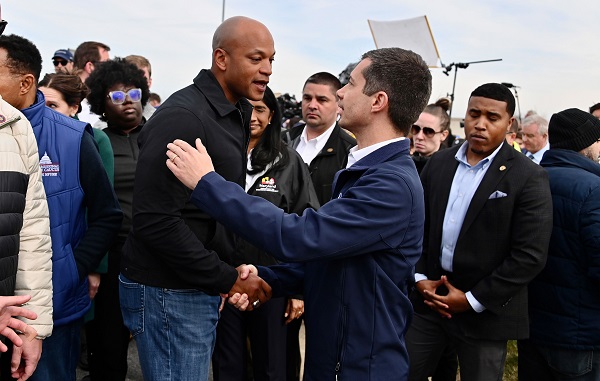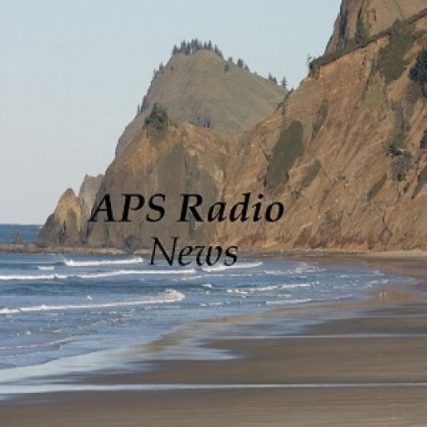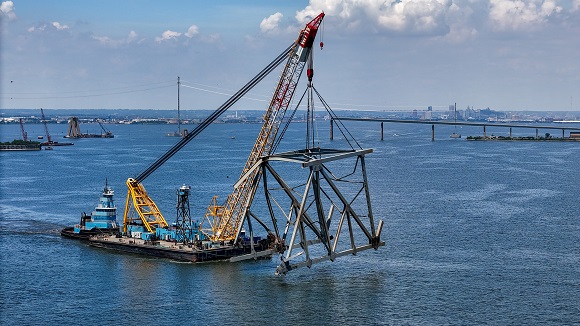By Hayes Gardner and Dana Munro
Baltimore Sun Key Bridge online news
(Baltimore Sun) — Engineering studies commissioned by the state of Maryland in the early 2000s contemplated vulnerabilities to the area’s critical bridges, including the possibility of a “ship impact” at the Francis Scott Key Bridge.
Shortly after the terrorist attacks of Sept. 11, 2001, and threats to California’s Golden Gate Bridge in November 2001, consultants studied potential threats to five bridges in the state of Maryland. Two Key Bridge-focused reports from 2002 and 2004 “recommended countermeasures to mitigate the [bridge’s] intentional destruction” and prompted a “feasibility study” for “pier protection” at the bridge, according to two studies and one slideshow from the time, obtained Friday evening by The Baltimore Sun in a Maryland Public Information Act request filed in May.
Pier protection is any structural fortification at or around a bridge support designed to prevent or mitigate a collision.
These studies — although heavily redacted — shed light on what state officials knew about the bridge’s potential susceptibility decades before it was decimated on March 26 by a 984-foot container ship named the Dali. The collapse killed six construction workers who had been fixing potholes on Interstate 695 and sent 50,000 tons of debris into the Patapsco River, blocking the shipping channel for months.
“Small-scale pier protection” at five bridges — the Chesapeake Bay Bridge, the Thomas J. Hatem Bridge, the Millard Tydings Bridge, the Harry W. Nice Bridge and the Key Bridge — was evaluated in 2001 and 2002, according to the slideshow.
Key Bridge online news
The reports and slideshow were completed by engineering consultants Ammann & Whitney Consulting Engineers, which performed a site visit at the Key Bridge in April 2002, and Wallace Montgomery & Associates. They provided the documents to the Maryland Transportation Authority, which owns the five spans, including the Key Bridge.
The vast majority of the slideshow and reports’ 160 pages were redacted before the transportation authority provided the documents to The Sun, but the remaining words offer hints into the studies. Subsections of the 2002 analysis into the Key Bridge include: “identification of possible threats,” feasible security measures for “ship impact,” and feasible security measures for “explosive threats.”
(Please click onto the photo of the pretty cat of 1999 to hear Classic Rock & Oldies)

The documents were redacted, in part, the transportation authority said, because releasing the information could “jeopardize the security of transportation facilities and/or structures, aid in the planning of a terrorist attack, or endanger the safety of MDTA employees and the public.”
Former Maryland transportation officials have said that, after 9/11, there were concerns about terrorists targeting the Key or Bay Bridge, and the early 2000s reports seem to focus on an intentional act, rather than an accident. The 2004 study includes a page from a 1946 analysis — written by multiple federal defense agencies created during World War II — entitled “Effects of Impact and Explosion.”
The Dali, which was guided by two Maryland harbor pilots, did not intend to crash into the Key Bridge, but lost power as it departed Baltimore. The National Transportation Safety Board, which is investigating the incident, is focused on the “electrical power distribution system” of the vessel.
One unredacted phrase from the 2004 report reads, “feasibility study for stand-off pier protection at the Francis Scott Key Bridge.” An example of “stand-off pier protection,” City College of New York civil engineering professor Anil Agrawal told The Sun Friday, is a“dolphin,” which is an artificial island built to deflect wayward ships.
Key Bridge online news
Roughly 4,000 vessels transited under the Key Bridge annually, the 2002 study noted, and the Key Bridge did have four dolphins, meant to protect the span’s piers. However, they were built, like the bridge, in 1977, and were small and inadequate by modern standards, given the exponential increase in ship sizes in recent decades.
It appears that the price of additional pier protection was studied, too. The slideshow notes a “cost/benefit evaluation,” with unredacted bullet points including, “available detours,” “user costs” and “replacement costs.”
At the time of the first report, Democrat Parris Glendening was the governor of Maryland. In 2003, Republican Bob Ehrlich took office, serving until 2007.

Glendening, in an interview with The Sun on Saturday, said he generally recalled the study that took place toward the end of his second term and thought about it when the bridge collapse occurred. The inaction, he said, was likely due to the quantity of safety concerns and corresponding studies in separate state government entities taking place at the time.
“The terrorist threat was very real in my mind and other people’s mind,” Glendening said, adding what an attack in Maryland could look like was impossible to predict but all departments were doing what they could to examine how to mitigate it.
Lots of studies were done around various threats, but few made it past that stage, he said, adding that a more comprehensive safety plan was called for and never occurred.
“I think we should have been much more aggressive,” he said, and put in place “a multi-administration and multi-level government effort.
“A lot of it was start and stop, studies and discussions but very little real action,” said Glendening, who served two terms as Maryland governor starting in 1995.
Key Bridge online news
Robert Flanagan, who served as the state’s transportation secretary from 2003 to 2007, said he doesn’t recall specific studies about bridge protection, nor does he know whether the Maryland Transportation Authority pushed for action. However, he does remember the enormous demands placed on the department in the aftermath of 9/11 and the need and expense associated with meeting new and evolving federal transportation safety requirements as well as developing state regulations during this time.
“We were all on pins and needles worrying about vulnerabilities of the transportation system,” Flanagan said. “We were concerned about transit. We were concerned about airports and we were concerned about bridges like this one and we were always trying to fortify ourselves.”
He recalled many aircraft regulation projects during that period, as well as concern around the port and what kinds of products could traverse international waters. Certain extra safety measures were put in place to ensure all incoming cargo was safe, which Flanagan partly credits for the lack of disasters related to the port.
“That was a huge effort that was underway and very expensive,” Flanagan said. “Before 9/11 we’d just let the stuff in and then all of a sudden we had to have all this information about a container and where it came from.”
When administrations turn over, outgoing state officials brief incoming ones on projects that didn’t get started in the prior term, Flanagan said, adding that subsequent governors and state transportation leadership officials likely possessed the information in the studies and also chose not to undertake the kinds of measures offered within them.
While Flanagan could not speak directly to any specific study, he said that cost would have been a factor in any decision.
Key Bridge online news
“We didn’t kill it. We didn’t turn it down. We never said this is a bad idea. It was a question of finding a place in the budget to work on it and unfortunately no one did,” Flanagan said.
The reports were not the last time that agencies in Maryland considered stronger pier protection at the Key Bridge.
The Port of Baltimore Harbor Coordination and Safety Committee — a cross section of government agencies and maritime groups that do not have decision-making authority, but serves as a forum for quarterly discussions — has discussed the possibility of a ship hitting either the Key Bridge or Bay Bridge several times in the last two decades.
During a 2007 meeting, attendees discussed the potential of nonphysical pier protection at three Maryland bridges, “based on a 2003 feasibility study for Bridge pier protection,” according to meeting minutes. At that time, one Maryland harbor pilot, Joe Smith, “reiterated his concern that the bridges should be retrofitted with enhanced bridge protection systems to prevent damage resulting from a potential ship strike.”
Cost is inherent with any transportation project, though, and the price of protection was discussed in a 2014 meeting, during which attendees noted Maryland is one of the “few states” that does not protect its bridges from “ship strikes,” per the minutes. Pilots suggested “any protection would have an economic value,” while a Coast Guard official, John Walters, said that “protecting bridges from ship strikes would cost Maryland a substantial amount of money.” A Maryland Port Administration official suggested at the time he would look into a “FEMA grant as a potential funding source.”
Key Bridge online news
Adding pier protection to an existing bridge is not inexpensive and it took decades for local officials to identify funds for a $95 million project to build dolphins for the Delaware Memorial Bridge near Wilmington. Calamity is costly, too, as the new Key Bridge’s price tag is roughly $1.7 billion, a figure that does not compute the disaster’s impact on the region’s economy, nor the six men who died in the collapse.
The replacement Key Bridge is expected to have a wider main span — placing the piers farther from the shipping channel, thus lowering the risk of vessel collision — and likely some sort of physical barriers, such as islands, protecting the piers. By Labor Day, the transportation authority plans to identify the contracted builder of the new bridge.
The authority is considering adding pier protection at the Bay Bridge, too, by the 2027-28 winter. The initial budget for the project is $145 million.
Back when the Key Bridge was studied in 2002, the consultant analysis noted the potential consequences of a bridge closure. Two decades later, those ramifications became an all-too-horrible, and ongoing, reality.
“The detour length for the bridge, in the event of a bridge closing[,] is approximately 25 miles,” the 2002 report stated. “The bridge is a vital link in the Maryland highway system and its importance to the economy of the region is critical.”
©2024 Baltimore Sun. Visit baltimoresun.com. Distributed by Tribune Content Agency, LLC.
Key Bridge online news


